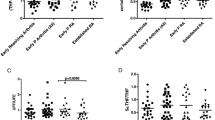Abstract
Rheumatoid arthritis is a systemic disease that causes inflammation and joint destruction. As a result of pathological destruction in bone and cartilage, crosslinks in collagen are resorbed more rapidly. This causes a rise in circulating collagen crosslink levels and their urinary excretion. In RA, apart from the crosslink resorption at the site of inflamed joints, there may be increased resorption due to general bone loss associated with disease activity. The aim of this study was to evaluate the influence of therapy with infliximab on urinary excretion of pyridinoline (PYD) and deoxypyridinoline (DPYR) as a markers of collagen degradation and its correlation with clinical and biochemical parameters of disease activity. Seventeen patients with active rheumatoid arthritis treated with infliximab were recruited into the study. The therapy resulted in the reduction in the symptoms of RA and urinary excretion of PYD and DPYR. The urinary excretion of PYD correlated with a number of swollen joints, morning stiffness, CRP and ESR. The urinary excretion of DPYR correlated during infliximab therapy with the number of swollen and tender joints and morning stiffness. The measurement of urinary excretion of PYR and DPYR may give insight into bone metabolism and help us to better understand the actual changes in bone and cartilage caused by RA and its treatment.
Similar content being viewed by others
Abbreviations
- DPYR:
-
Deoxypyridinoline
- PYR:
-
Pyridinoline
- RA:
-
Rheumatoid arthritis
References
Sambrook PN (2000) The skeleton in rheumatoid arthritis: common mechanisms for bone erosion and osteoporosis? J. Rheumatol 27:2541–2542
Joffe I, Epstein S (1991) Osteoporosis associated with rheumatoid arthritis: pathogenesis and management. Semin Arthritis Rheum 20:256–272
Taylor PC (2003) Anti-TNF alpha therapy for rheumatoid arthritis: an update. Intern Med 432:15–20
Cairns AP, Taggart AJ (2002) Anti-tumor necrosis factor therapy for severe inflammatory arthritis: two years of experience in Northern Ireland. Ulster Med J 71:101–105
Emery P (1994) Assessment of rheumatoid arthritis a clinician’s viewpoint. J Rheumatol (Suppl.) 42:20–24
Garnero P, Delmas PD (1996) New developments in biochemical markers for osteoporosis. Calcif Tissue Int 59 (Suppl. 1): 82–89
Seibel MJ, Duncan A, Robins SP (1989) Urinary hydroxypyridinium crosslinks provide indices of cartilage and bone involvement in arthritic diseases. J Rheumatol 16:964–970
Spector TD, James IT, Hall GM, Thompson PW, Perrett D, Hart DJ (1993) Increased levels of urinary collagen crosslinks in females with rheumatoid arthritis. Clin Rheumatol 12:240–244
Gough AK, Peel NF, Eastell R, Holder RL, Lilley J, Emery P (1994) Excretion of pyridinium crosslinks correlates with disease activity and appendicular bone loss in early rheumatoid arthritis. Ann Rheum Dis 53:14–17
Gough AK, Lilley J, Eyre S, Holder RL, Emery P (1994) Generalised bone loss in patients with early rheumatoid arthritis. Lancet 344:23–27
Ared WP, Dayer J-M (1990) Cytokines and cytokine inhibitors or antagonists in rheumatoid arthritis. Arthritis Rheum 33:305–315
Okamoto H, Yamamura M, Morita Y, Harada S, Makino H, Ota Z (1997) The synovial expression and serum levels of interleukin-6, interleukin-11, leukemia inhibitory factor, and oncostatin M in rheumatoid arthritis. Arthritis Rheum 40:1096–1105
Manicourt DH, Triki R, Fukuda K, Devogelaer J-P, Nagant de Deuxchaisnes C, Thonar EJ-MA (1993) Levels of circulating tumor necrosis factor α and interleukin-6 in patients with rheumatoid arthritis: relationship to serum levels of hyaluronan and antigenic keratan sulfate. Arthritis Rheum 36:490–499
Fujimoto D, Akiba K, Nakamura N (1977) Isolation and characterization of a fluorescent material in bovine Achilles tendon collagen. Biochem Biophys Res Commun 76:1124–1129
Robins SP (1983) Cross-linking of collagen. Isolation, structural characterization and glycosylation of pyridinoline. Biochem J 215:167–173
Ogawa T, Ono T, Tsuda M, Kawanishi Y (1982) A novel fluor in insoluble collagen: A crosslinking moiety in collagen molecule. Biochem Biophys Res Commun 107:1252–1257
Eyre DR, Wu JJ, Woods PE (1991) The cartilage collagens: Structural and metabolic studies. J Rheumatol 18 (Suppl. 27):49–51
Eyre DR, Koob TJ, Van Ness KP (1984) Quantitation of hydroxypyridinium crosslinks in collagen by high-performance liquid chromatography. Anal Biochem 137:380–388
Black D, Duncan A, Robins SP (1988) Quantitative analysis of the pyridinium crosslinks of collagen in urine using ionpaired reversed-phase high-performance liquid chromatography. Anal Biochem 169:197–203
Eyre DR (1987) Collagen cross-linking amino acids. Meth Enzymol 144:115–139
Knott L, Bailey AJ (1998) Collagen cross-links in mineralizing tissues: A review of their chemistry, function, and clinical relevance. Bone 22:181–187
Author information
Authors and Affiliations
Corresponding author
Rights and permissions
About this article
Cite this article
Ostanek, L., Pawlik, A., Brzosko, I. et al. The urinary excretion of pyridinoline and deoxypyridinoline during rheumatoid arthritis therapy with infliximab. Clin Rheumatol 23, 214–217 (2004). https://doi.org/10.1007/s10067-003-0856-5
Received:
Accepted:
Published:
Issue Date:
DOI: https://doi.org/10.1007/s10067-003-0856-5




